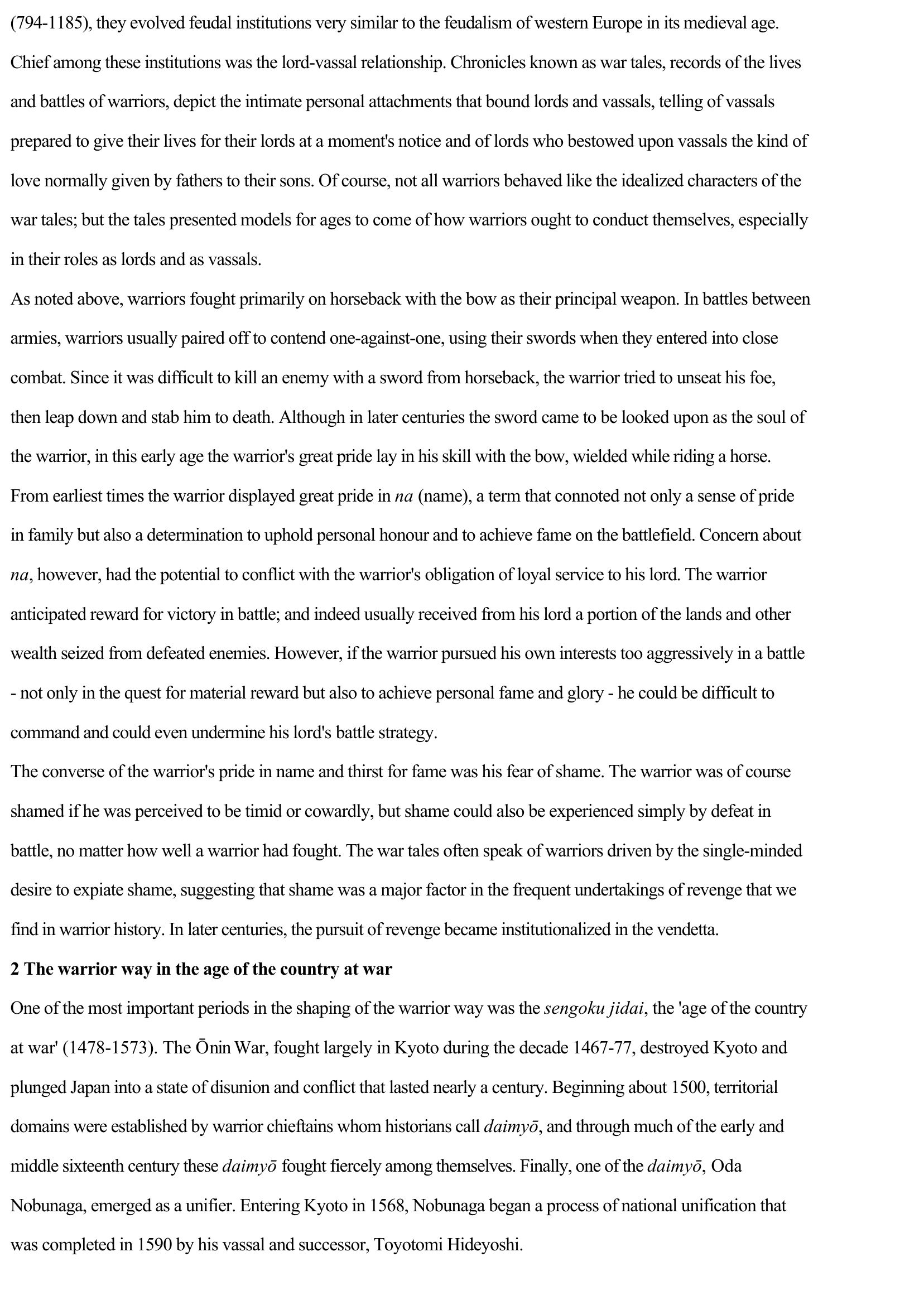Bushi philosophy
Publié le 22/02/2012

Extrait du document
«
(794-1185), they evolved feudal institutions very similar to the feudalism of western Europe in its medieval age.
Chief among these institutions was the lord-vassal relationship.
Chronicles known as war tales, records of the lives
and battles of warriors, depict the intimate personal attachments that bound lords and vassals, telling of vassals
prepared to give their lives for their lords at a moment's notice and of lords who bestowed upon vassals the kind of
love normally given by fathers to their sons.
Of course, not all warriors behaved like the idealized characters of the
war tales; but the tales presented models for ages to come of how warriors ought to conduct themselves, especially
in their roles as lords and as vassals.
As noted above, warriors fought primarily on horseback with the bow as their principal weapon.
In battles between
armies, warriors usually paired off to contend one-against-one, using their swords when they entered into close
combat.
Since it was difficult to kill an enemy with a sword from horseback, the warrior tried to unseat his foe,
then leap down and stab him to death.
Although in later centuries the sword came to be looked upon as the soul of
the warrior, in this early age the warrior's great pride lay in his skill with the bow, wielded while riding a horse.
From earliest times the warrior displayed great pride in na (name), a term that connoted not only a sense of pride
in family but also a determination to uphold personal honour and to achieve fame on the battlefield.
Concern about
na, however, had the potential to conflict with the warrior's obligation of loyal service to his lord.
The warrior
anticipated reward for victory in battle; and indeed usually received from his lord a portion of the lands and other
wealth seized from defeated enemies.
However, if the warrior pursued his own interests too aggressively in a battle
- not only in the quest for material reward but also to achieve personal fame and glory - he could be difficult to
command and could even undermine his lord's battle strategy.
The converse of the warrior's pride in name and thirst for fame was his fear of shame.
The warrior was of course
shamed if he was perceived to be timid or cowardly, but shame could also be experienced simply by defeat in
battle, no matter how well a warrior had fought.
The war tales often speak of warriors driven by the single-minded
desire to expiate shame, suggesting that shame was a major factor in the frequent undertakings of revenge that we
find in warrior history.
In later centuries, the pursuit of revenge became institutionalized in the vendetta.
2 The warrior way in the age of the country at war
One of the most important periods in the shaping of the warrior way was the sengoku jidai , the 'age of the country
at war' (1478-1573).
The Ōnin War, fought largely in Kyoto during the decade 1467-77, destroyed Kyoto and
plunged Japan into a state of disunion and conflict that lasted nearly a century.
Beginning about 1500, territorial
domains were established by warrior chieftains whom historians call daimy ō , and through much of the early and
middle sixteenth century these daimyō fought fiercely among themselves.
Finally, one of the daimy ō , Oda
Nobunaga, emerged as a unifier.
Entering Kyoto in 1568, Nobunaga began a process of national unification that
was completed in 1590 by his vassal and successor, Toyotomi Hideyoshi..
»
↓↓↓ APERÇU DU DOCUMENT ↓↓↓
Liens utiles
- POUR UNE PHILOSOPHIE DE LA SOLITUDE [A Philosophy of solitude]. (résumé) de John Cowper Powys
- Bertrand Russell par Anthony Quinton University Lecturer in Philosophy and Fellow of New College Oxford Incessamment actif, Bertrand Russell a passé longue vie en public.
- Western Philosophy.
- Chinese philosophy
- Byzantine philosophy

































